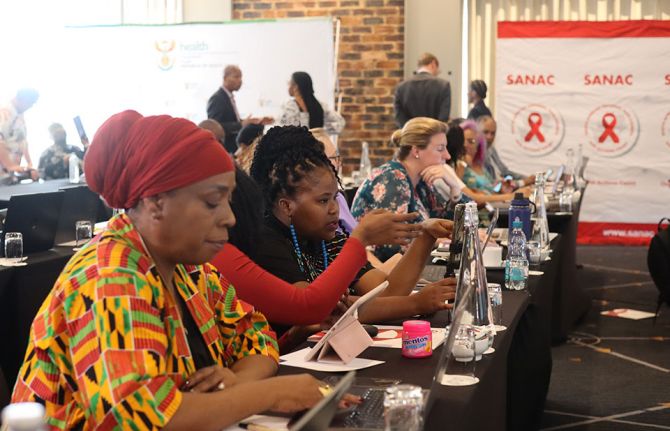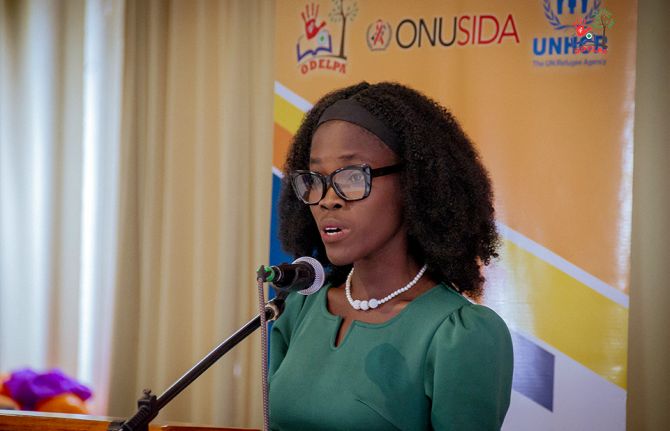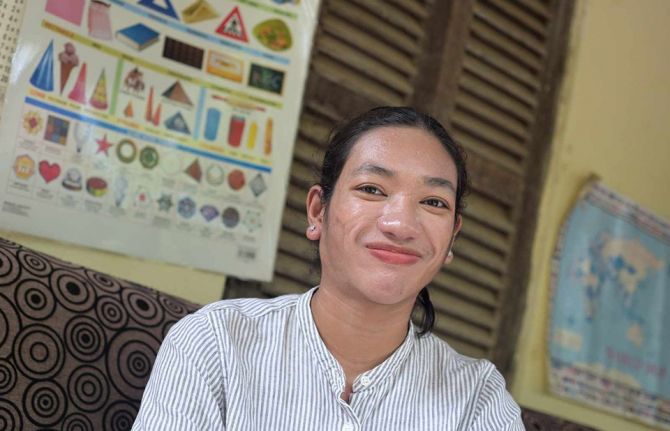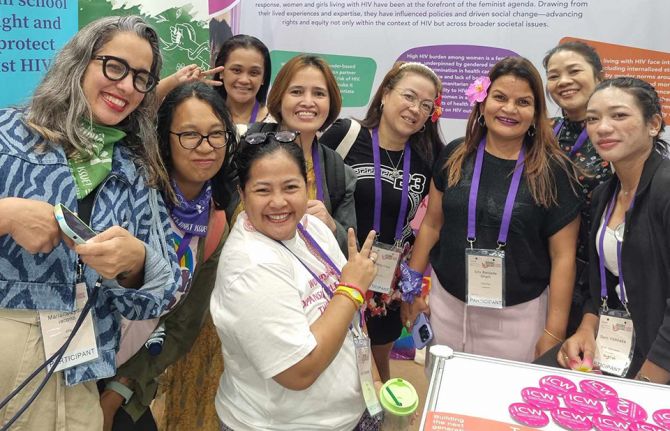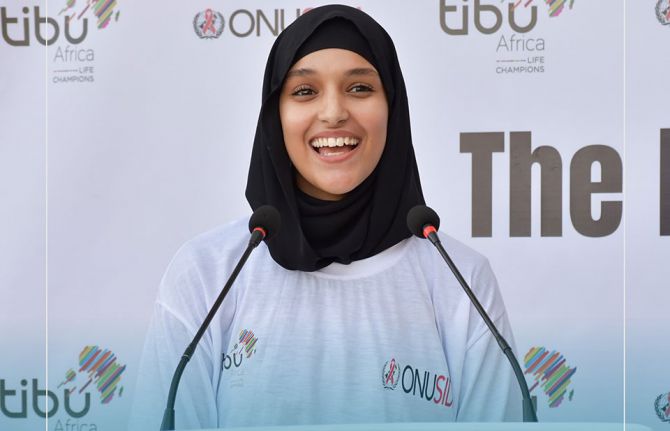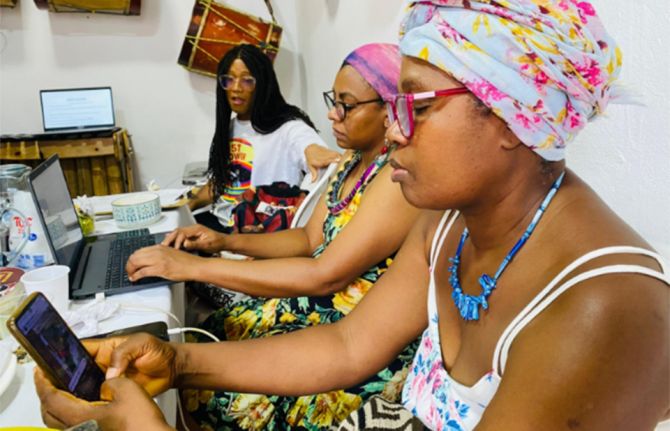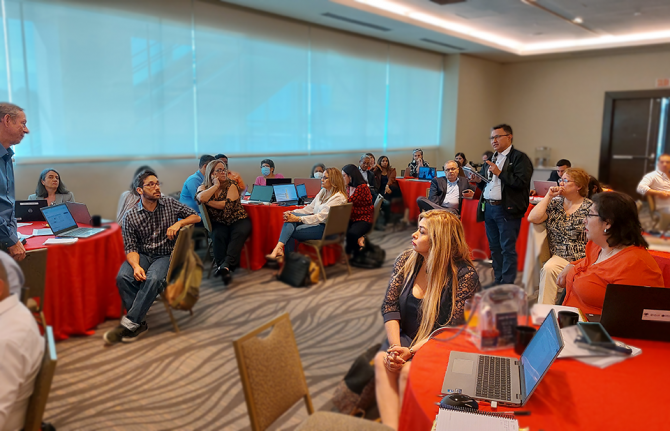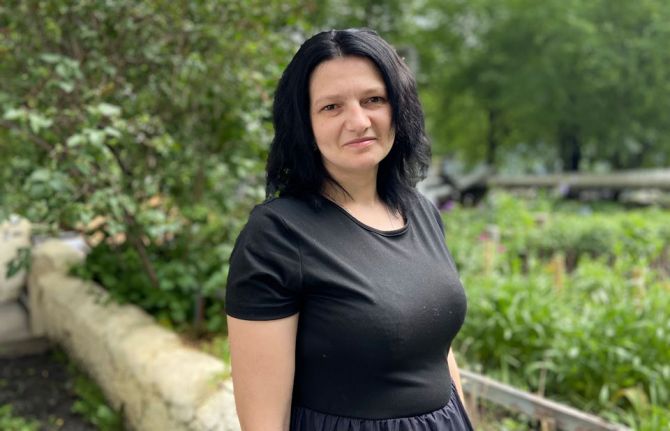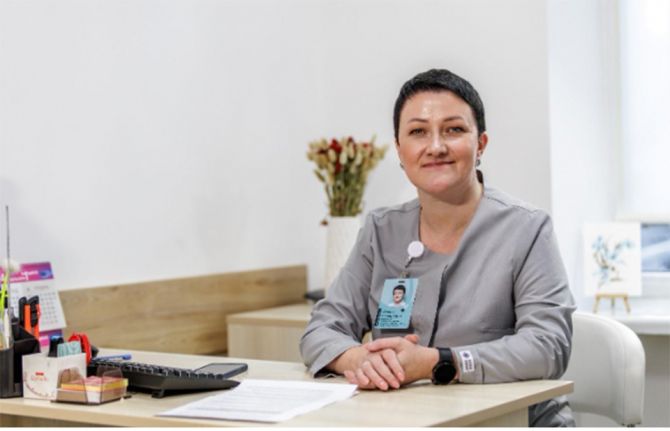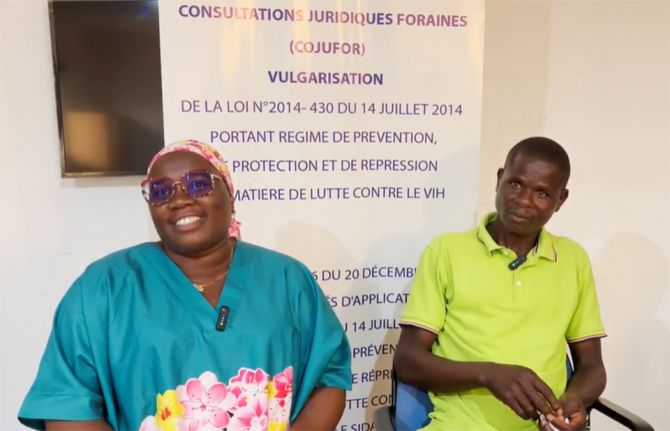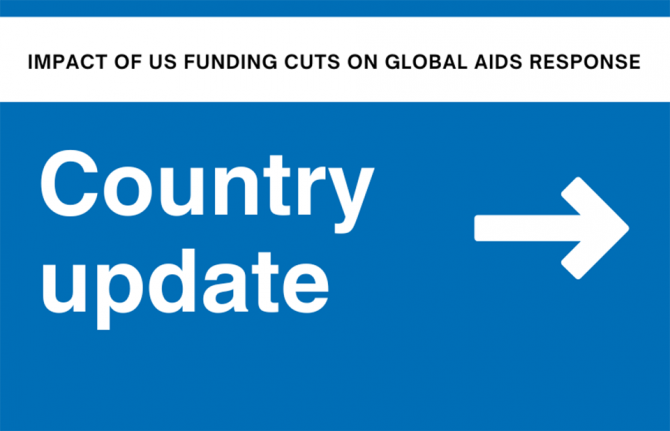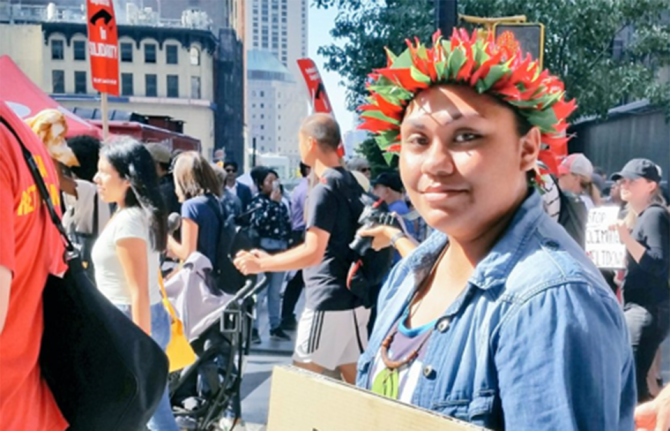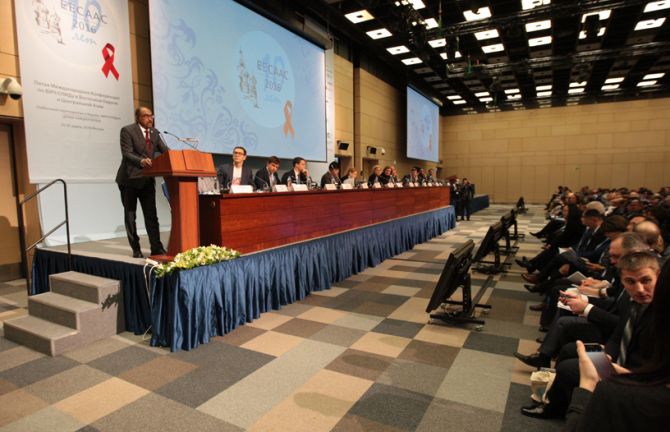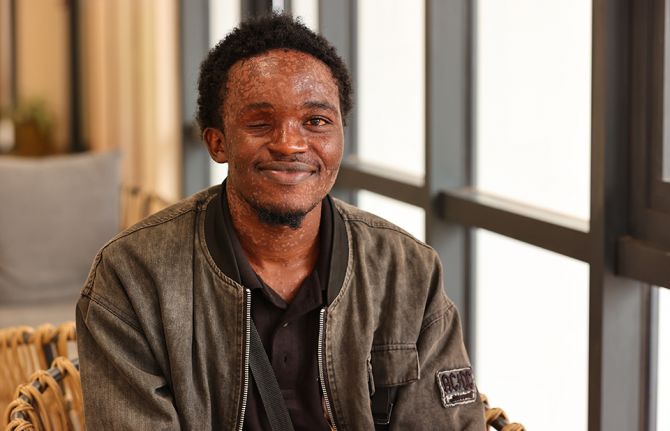
Feature Story
Barber Shops and Beauty Salons promote HIV education in Guyana
26 March 2009
26 March 2009 26 March 2009This story was first published on UNFPA.org

Clients at Kevin's Reflextions have an opportunity to talk about HIV.
Credit: Carina Wint
Barber shops across Georgetown, Guyana, are buzzing with chatter about the latest trends, community happenings, neighbourhood gossip and now, ways to protect young people from AIDS. The United Nations Population Fund (UNFPA), in collaboration with UNAIDS Secretariat, has identified barber shops and beauty salons as information hubs, and is using them to spread the word about HIV prevention.
The project involves the training of shop staff to answer simple HIV-related questions, pass out informational material, dispense both male and female condoms to clients – and even provide on-site counselling and testing. As a result, young people in Guyana are given access to information and resources not readily available elsewhere in their communities. And this is important because their small country (population 751, 223) has one of the highest HIV prevalence levels in the region: about 1.6 per cent for pregnant women, according to UNAIDS. Among sex workers, prevalence rises up to 26.6 per cent.

Male and female condoms are available at selected hair salons.
Credit: Carina Wint
Juanita Huburn, a customer at DJ’s Magic Fingers, a hair salon that participates in the programme, described Guyanese society as “closed” when it comes to issues regarding sexuality. “You do not talk about sex, they just say you should not have sex, but this is not realistic,” she said.
Shops and salons were chosen based on their location in malls, parks, popular attractions, or low-income communities. Owners who opened their doors to the project got added marketing exposure for their small businesses and were provided with incentives, such as access to promotional materials. “Shops were informed how their companies would be promoted through the project, and the economic value of participating,” said UNFPA Guyana Liaison Officer, Patrice La Fleur “They would most importantly provide safe places to discuss sexuality and the prevention of HIV.”
Shops were informed how their companies would be promoted through the project, and the economic value of participating. They would most importantly provide safe places to discuss sexuality and the prevention of HIV.
UNFPA Guyana Liaison Officer, Patrice La Fleur
Once the locations were identified, two employees from each shop were sent for training on basic HIV education and prevention means. They were also taught to properly monitor the project and introduced to safe practices within the context of their own work (for example, ensuring the sterility of hair cutting machines, razors, needles for stitching and weaving, manicure and pedicure implements, and tattooing and body piercing equipment).
In addition to training participants about sexual and reproductive health and gender issues, the project also focuses on building life skills such as communication, healthy relationships, and leadership. “Participants expressed personal gains in their quality of relationships with friends, family, and clients,” said UNFPA Programme Officer, Babsie Giddings who monitors the project.

DJ's Magic Fingers hair salon is another venue for building awareness of HIV prevention.
Credit: Carina Wint
Since the programme was put in place businesses report a steady boost in clientele and more shops have come on board. “Business has increased about 5 per cent since we joined this programme,” said Kevin John, owner of the Barber Shop Kevin’s Reflections. He believes it may be partly because people know his salon equipment is sanitized. Currently over 7000 male and 400 female condoms are distributed monthly by requests in the shops and salons.
Work on the project was initiated last year through efforts of the UN Country Theme Group and it has been fully funded by UNAIDS. Also collaborating on the project is a local NGO, Youth Challenge Guyana.
UNFPA provides continuous support with regular follow-ups and monitoring for participating barber shops and salons. The project aims to afford some 2000 young people access to information, skills, services and supplies they can use to protect their health.
Right Hand Content
Cosponsors:
Feature stories:
Condoms and HIV prevention: Position statement by UNAIDS, UNFPA and WHO (19 March 2009)
Challenging violence against women a key task for newly launched Caribbean Coalition on Women, Girls and AIDS (06 March 2009)
More prevention focus needed for the Caribbean to sharpen its response to HIV (22 December 2008)
Publications:
Keeping Score II: A progress report towards universal access to prevention, treatment, care and support in the Caribbean (pdf, 2,87 Mb)

Feature Story
Highlighting sexual violence on International Women’s Day
05 March 2009
05 March 2009 05 March 2009
"Women and men: United to end violence against women" is the theme of this year’s International Women's Day which is observed at the United Nations on 5 March 2009 and celebrated internationally on 8 March.
Sexual violence, and the threat of violence, increases women’s vulnerability to HIV and in certain parts of the world is being used as a tactic of war.
UN Secretary-General Ban Ki-moon highlights this in his message marking International Women’s Day: “Violence against women is also linked to the spread of HIV/AIDS. In some countries, as many as one in three women will be beaten, coerced into sex or otherwise abused in her lifetime. Women and girls are also systematically and deliberately subject to rape and sexual violence in war.”
UNAIDS Executive Director Michel Sidibé is also unequivocal on the need to end this violence in his statement: “Violence, including rape and sexual abuse against women and girls should not be tolerated in any circumstances, be it in conflict or war or at home in our own communities.”
Sexual violence in conflict
Sexual violence in conflict has not been a high priority for security institutions and is often overlooked due to stigma and under-reporting. However, the trauma and terror of rape can wound as deeply as bullets and in areas with high HIV prevalence, women are also at risk of being infected with HIV.
Leo Kenny, Team Leader of UNAIDS Security and Humanitarian Response is convinced of the pressing need to address the issue sexual violence among the uniformed services: “While soldiers and uniformed service personnel have been perpetuators of violence against women, they have also been part of the solution and are potential key agents of change if the right programmes are put in place.”
“Educating and involving peacekeepers in addressing sexual violence is important as soldiers have influence among their peers both within the service and the wider community. By changing their perceptions and behaviours it can positively impact the larger population,” Mr Kenny added.
"Violence, including rape and sexual abuse against women and girls should not be tolerated in any circumstances, be it in conflict or war or at home in our own communities."
UNAIDS Executive Director Michel Sidibé
The women who survive sexual violence need access to comprehensive health and counselling services and, where necessary, HIV prevention, treatment, care and support. However the context of civil unrest can result in barriers to universal access to these services.
There is also a need for the millions of uniformed service personnel worldwide to be integrally considered in the scale up towards universal access to HIV prevention, treatment, care and support.
UN Action against Sexual Violence in Conflict
 "Women and men: United to end violence against women" is the theme of this year’s International Women's Day which is observed at the United Nations on 5 March 2009 and celebrated internationally on 8 March. Credit: UNAIDS
"Women and men: United to end violence against women" is the theme of this year’s International Women's Day which is observed at the United Nations on 5 March 2009 and celebrated internationally on 8 March. Credit: UNAIDSTwo years ago today, UN bodies came together to form a joint initiative, “UN Action against Sexual Violence in Conflict.” The partnership now stands at twelve UN entities which seek to draw attention to the issue of sexual violence in conflict and the need to do more, to improve the quality of programming to address sexual violence, to increase the coordination of efforts for comprehensive prevention and response services, and to improve accountability as well as to respond effectively to the needs of survivors.
The UN Action initiative is designed to create greater awareness of these abuses and, ultimately, end sexual violence to make the world safer for women and girls.
Three main pillars
The first aspect of this initiative, country level action, involves country level support and efforts to build capacity and train advisers in gender-based violence programming and coordination, as well as support for joint UN programming in selected countries.
Second, “advocating for action”, raises public awareness and generates political will to address sexual violence as part of the broader campaign to “Stop rape now.” The third aspect is the creation of a knowledge hub on sexual violence in conflict and effective responses.
Stop rape now
Rape has deep roots in a historical absence of accountability and UN Action has helped catalyze a paradigm shift: insisting that sexual violence is recognized as a security threat that demands a security response, rather than simply an inevitable byproduct of war.
International Women’s Day
In 1977 the UN General Assembly adopted a resolution inviting Member States to proclaim a United Nations Day for Women's Rights and International Peace—International Women's Day—in recognition of the fact that securing peace and social progress and the full enjoyment of human rights and fundamental freedoms require the active participation, equality and development of women; and to acknowledge the contribution of women to the strengthening of international peace and security.
For women around the world, the symbolism of International Women's Day has a wider meaning: it’s an occasion to celebrate how far women have come in their struggle for equality and an opportunity to unite, network and mobilize for meaningful change.
Highlighting sexual violence on International Women’s Day
International Women's Day 2009 statements:
Statement by UN Secretary-General Ban Ki-moon (pdf, 25 kb)
Statement by UNAIDS Executive Director Michel Sidibé
Statement by WHO Director-General Dr Margaret Chan
Statement by UNESCO Director-General Koïchiro Matsuura (pdf, 61 Kb)
Statement by UNFPA Executive Director, Thoraya Ahmed Obaid
Statement by UNICEF Executive Director Ann M. Veneman
More from UNAIDS Cosponsors on International Women's Day:
Interview with WFP Head of Gender Unit Isatou Jallow
UNDP's special on the occasion of the International Women's Day 2009
UNODC's special on the occasion of the International Women's Day 2009
ILO celebration for International Women's Day 2009
World Bank's special on the occasion of the International Women's Day 2009
Cosponsors:
UNDP - UN Development Programme
UNFPA - United Nations Population Fund
UNHCR - UN High Commissioner for Refugees
UNICEF - United Nations Children Fund
WFP - World Food Programme
WHO – World Health Organization
Partners:
DPA - Department of Political Affairs
DPKO - Peacekeeping Best Practices
OCHA - Coordination of Humanitarian Affairs
OHCHR - United Nations Human Rights
UNIFEM - UN Development Fund for Woman
Feature stories:
HIV prevention and the uniformed services in CIS (08 October 2008)
Contact:
For more information on this campaign contact by email: anna.tarant@unifem.org
External links:

Feature Story
Costa Rica: Peer HIV prevention programmes to be promoted for young people
03 March 2009
03 March 2009 03 March 2009
The President of the Republic of Costa Rica, Mr Óscar Arias signing the HIV prevention and education agreement.
Young people in Costa Rica will be receiving information on HIV prevention and healthy lifestyles from their peers thanks to a new agreement signed in San Jose by the Government of Costa Rica and the United Nations.
The agreement establishes that young people, aged 15 – 25 years, will lead in sharing sexual health information among their peers in two provinces: Limón and Puntarenas. The young leaders will provide education on a wide range of issues such as modes of HIV transmission and how to use a condom.
UNAIDS Regional Director Dr César Núñez emphasized that only timely information and HIV prevention can stop the spread of HIV. “It is urgent to provide young people with HIV information and to include sexual education in the school curriculum, as well as to develop specific strategies for the population outside schools,” he said.
"It is urgent to provide young people with HIV information and to include sexual education in the school curriculum, as well as to develop specific strategies for the population outside schools."
UNAIDS Regional Director Dr César Núñez
The agreement was signed on 24 February 2009 by the President of the Republic Mr Óscar Arias and the Deputy Minister of Youth Karina Bolaños together with Dr César Núñez, UNAIDS Regional Director, Nils Kastberg, UNICEF Regional Director for Latin America and the Caribbean, Luis Mora, UNFPA Regional Adviser in Gender and Masculinities, and young people from the Limón and Puntarenas provinces.
A 2008 study carried out by UNFPA and UNICEF with support from UNAIDS showed that the majority of young people in Costa Rica were sexually active at the age of 16. The study also highlighted that there was lack of HIV information and knowledge among Costa Rican youth.
For that reason, President Arias, who received a Nobel Peace prize in 1987, emphasized on the occasion of the signing the need to speak about sexual education openly and without prejudices. “Talking about sex cannot continue to be taboo in Costa Rica,” he said.
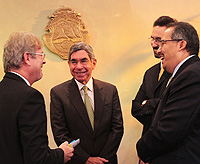
The President of the Republic of Costa Rica, Mr Óscar Arias (centre) talking with the United Nations representatives that signed the agreement.
The study shows that in Limón only about 28% of the young people interviewed know how to use a condom correctly whereas in Puntarenas the percentage drops to about 17%. Furthermore, in both provinces, more than 50% of the adolescents find that asking a partner to use a condom could be interpreted as a sign of mistrust. Finally, 43% in both provinces think that a young girl carrying condoms in her purse is a woman with a “doubtful reputation.”
The agreement signed will look at strengthening the capacity of the health and education institutions as well as youth and adolescents in the country to promote HIV prevention. UNICEF, UNFPA and UNAIDS will provide technical and financial assistance to the programme which plans to directly benefit 73,000 adolescents.
This agreement is a direct result of the Meeting of Ministers of Education and Health to prevent HIV in Latin America and the Caribbean, that took place in Mexico in August 2008 ahead of the International AIDS Conference, when Ministers signed an historic declaration pledging to provide comprehensive sex education as part of the school curriculum in Latin America and the Caribbean.
Costa Rica: Peer HIV prevention programmes to be promoted for young people
Feature stories:
Leaders pledge to promote sexual health to stop HIV in Latin America and the Caribbean (03 August 2008)

Feature Story
Third stocktaking report on children and AIDS
01 December 2008
01 December 2008 01 December 2008
The report, titled Children and AIDS: Third stocktaking report, was jointly prepared by UNICEF, the World Health Organization (WHO), the Joint United Nations Programme on HIV/AIDS (UNAIDS) and the United Nations Population Fund (UNFPA).
Early diagnosis and treatment can significantly improve the prospects for survival of newborn babies exposed to HIV, according to a report released today by four United Nations agencies.
The report, titled Children and AIDS: Third stocktaking report, was jointly prepared by UNICEF, the World Health Organization (WHO), the Joint United Nations Programme on HIV/AIDS (UNAIDS) and the United Nations Population Fund (UNFPA).
This report is the third review of progress on how AIDS affects children and young people since the Unite for Children, Unite against AIDS campaign was launched in October 2005 by UNICEF, UNAIDS and other partners with a commitment to be accountable for results.
Unite for Children, Unite against AIDS is a call to action around the impact of HIV and AIDS on children. It focuses on the needs of children in four key areas, known as the “Four Ps”: Preventing mother-to-child transmission of HIV; Provision of paediatric treatment; protection and support of children affected by AIDS; and prevention of infection among adolescents and young people.
This 2008 Stocktaking Report examines data on progress, emerging evidence, and current knowledge and practice for children as they relate to the four programme areas. The report also calls for actions in the next one to three years that can significantly improve prospects for children and women affected by AIDS. These initiatives involve changes in thinking, as well as concrete actions.
Prevention of mother-to-child transmission of HIV
Most pregnant women diagnosed with HIV do not have access to essential care and treatment, including antiretroviral therapy for their own health, to further reduce HIV transmission and prevent orphaning, according to the new report. Far too few pregnant women know their HIV status. In 2007, only 18% of pregnant women in low- and middle-income countries where data were available were tested for HIV, and of those who tested positively for HIV, only 12% were further screened to determine the status of the HIV disease and the type of treatment they require. Addressing mothers’ needs for diagnosis and treatment will improve not only their own overall health but their children’s survival.
Providing paediatric treatment and care
The report found that children under the age of one are not getting diagnosed and are missing out on treatment. As a result, large numbers of very young children are dying every year due to AIDS-related illnesses. Recent evidence found mortality levels reduced by up to 75% when infants were tested early and treated within the first 12 weeks of life. In 2007, however, only 10% of children born to HIV-positive women were tested before they were two months old. Therefore, the report advocates for increased testing to enable appropriate treatments to begin as early as possible.
Protection and care for children affected by AIDS
There is growing evidence in support of programming that addresses the wider context of children’s vulnerability as the basis to assist those children, families and communities directly affected by AIDS. The stocktaking report highlights that responses should be AIDS-sensitive and not AIDS-exclusive. While support to strengthen family and community responses to the epidemic remains a high priority, there is recognition of the need to support national protection systems, including government capacity to address child welfare generally.
Preventing infection among adolescent and young people
Significant numbers of young people continue to be infected with HIV each year, and girls in sub-Saharan Africa, in particular, remain vulnerable – 45% of all new infections occur in the 15–24 year-old age group. The new report argues that urgent attention is needed to address the greater HIV risks to girls of multiple concurrent partnerships, intergenerational sex, transactional sex and gender-based violence.
In countries with low-prevalence and concentrated epidemics, HIV prevention responses focused on adolescent risk behaviours – including injecting drug use, unprotected sex between males, and sex in exchange for gifts and money – are a priority. There is strong consensus that combination prevention programmes – integrating behavioural, structural and biomedical approaches – work.
This year’s report is accompanied by ‘Children and AIDS: Country Fact Sheets’, which present key statistical data on the “Four Ps” for 157 countries.
Third stocktaking report on children and AIDS
Cosponsors:
Press centre:
Early HIV Testing and Treatment Can Save Newborn Lives, New U.N. Report Released on World AIDS Day States (pdf, 80 Kb)
Feature stories:
Second stocktaking report on children and AIDS (03 April 2008)
Signs of progress in global response to Children and AIDS (16 January 2007)
External links:
Unite for Children, Unite against AIDS
Publications:
Children and AIDS: Third stocktaking report (pdf, 1.9 MB)
Children and AIDS: Third stocktaking report Summary (pdf, 2.71 MB)
Related
 Transgender sex workers face frequent abuse
Transgender sex workers face frequent abuse

29 March 2022
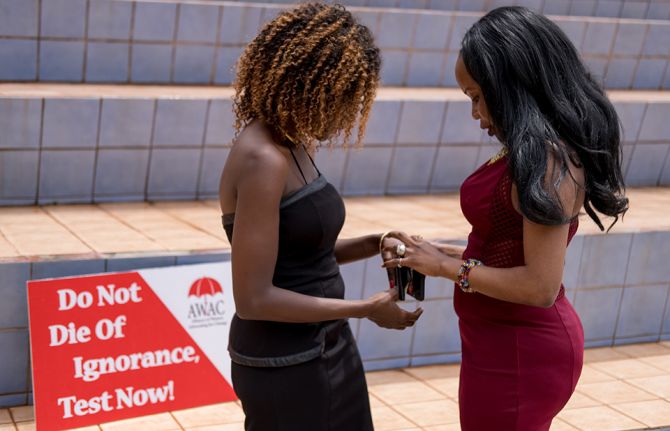 Many key populations avoid health services
Many key populations avoid health services

21 February 2022

Feature Story
New report on the State of the World Population
12 November 2008
12 November 2008 12 November 2008
Cultural sensitivity is critical for the success of development strategies according to a new report produced by the United Nations Population Fund (UNFPA). Credit UNFPA
Cultural sensitivity is critical for the success of development strategies according to a new report produced by the United Nations Population Fund (UNFPA). Reaching Common Ground: Culture, Gender and Human Rights, launched 12 November 2008, reports that culture is a central component of successful development of countries, and must be integrated into development policy and programming.
The State of World Population 2008 report affirms that development strategies that are sensitive to cultural values can reduce harmful practices against women and promote human rights, including gender equality and women’s empowerment.
Despite many declarations and affirmations in support of women’s rights, the report argues, gender inequality is widespread and deep-rooted in many cultures. Coercive power relations underlie practices such as child marriage - a leading cause of obstetric fistula and maternal death—and female genital mutilation or cutting. These and other harmful practices continue in many countries despite laws against them.
Gender inequality and HIV
The effects of gender inequality leave women and girls more at risk of exposure to HIV. Less access to education and economic opportunities results in women being more dependent on men in their relationships, and many who have no means of support must resort to bartering or selling sex to support themselves and their children. Where women can’t own property and lack legal protections, their dependence within their families is even greater. Economic and social dependence on men often limits women's power to refuse sex or to negotiate the use of condoms.
The report, which coincides with this year’s 60th anniversary of the Universal Declaration of Human Rights, is based on the concept that the international human rights framework has universal validity. Human rights express values common to all cultures and protect groups as well as individuals. The report endorses culturally sensitive approaches to the promotion of human rights, in general, and women’s rights, in particular.
Culturally sensitive approaches call for familiarity with how cultures work, and how to work with them. The report suggests that partnerships - especially with community-based institutions and leaders - can create effective strategies to promote human rights and end their abuses, such as female genital mutilation or cutting, wife inheritance or rape within marriage.
“Communities have to look at their cultural values and practices and determine whether they impede or promote the realization of human rights. Then, they can build on the positive and change the negative,” said Thoraya Ahmed Obaid, Executive Director of UNFPA
Therefore, The State of World Population report cautions that cultural sensitivity and engagement do not mean acceptance of harmful traditional practices, or a free pass for human rights abuses. Values and practices that infringe human rights can be found in all cultures. Understanding cultural realities can reveal the most effective ways to challenge these harmful cultural practices and strengthen beneficial ones.
The report concludes that analysing people’s choices in their local conditions and cultural contexts is a precondition for better development policies.
New report on the State of the World Population
Cosponsors:
Press centre:
Press release
Press summary (pdf, 127 Kb)
Feature stories:
Uniting against female genital mutilation (04 March 2008)
Publications:
Reaching Common Ground: Culture, Gender and Human Rights - The State of World Population report 2008 (pdf, 2.46 Mb)
Youth Supplement (pdf, 3.03 Mb)
Eliminating Female genital mutilation. An interagency statement. (pdf, 3.4 Mb)

Feature Story
Prevention is for life
25 August 2008
25 August 2008 25 August 2008
Belize: A programme coordinator with a
former gang member now actively involved
in HIV prevention and violence reduction
programmes. Credit: Carina Wint/UNFPA
HIV prevention is about saving lives. UNAIDS cosponsor, the United Nations Population Fund (UNFPA), has published an advocacy booklet telling the personal stories of people and communities who are making a difference in many corners of the world. "Prevention is for Life" puts a human face to these prevention efforts by telling real stories and accompanied by stunning photography.
In recent years, we have seen a substantial increase in HIV prevention efforts, and they are producing results in a number of heavily affected countries. However, the AIDS epidemic is not over in any part of the world—for every two people accessing HIV treatment, five are newly infected. HIV requires a long term response that is grounded in evidence and human rights.
The booklet starts with the story of how HIV peer education projects in street gangs in Belize are empowering young people to take responsibility within the youth community. In another corner of the world, Yulia is a young HIV-positive mother in Moscow struggling with stigma as well as the health impact of HIV but in her story she is hopeful for a brighter future for the next generation.

Tajikistan: Two young women share a
tender moment at UNFPA-sponsored Guli
Surkh, an NGO located in Dusnabe. Credit:
Warrick Page/UNFPA/Panos Pictures
A story of a micro-credit project in Tajikistan illustrates the connection between poverty, gender inequality, and vulnerability to HIV. With access to the micro-credit, migrant wives can gain financial independence and support their families. Again, it underlines that HIV is a development and human rights issue.
In China, messaging and condom promotion campaigns have been launched reaching out to the country’s large migrant population. In Egypt, HIV prevention services are reaching people who risk exclusion as mobile clinics and voluntary counselling and testing services are delivered to people living in Cairo’s poorest neighbourhoods.
Although HIV information, counselling, services and commodities such as male and female condoms are not revolutionary prevention concepts, ensuring access to these prevention tools is a challenge. This booklet shows vividly that it’s a challenge worth taking on as access to HIV prevention is making a real difference in people’s lives.
Prevention is for life

Feature Story
UNFPA: Reproductive and sexual health among youth in Tajikistan
30 June 2008
30 June 2008 30 June 2008.JPG)
A teenage girl and a young woman sit
together exploring the internet at the HIV
Shelter, “Guli Surkh”.
Credit: Warrick Page/PANO/UNFPA
The United Nations Populations Fund (UNFPA) is supporting a unique set of media and training interventions in Tajikistan designed to raise awareness, reduce stigma and provide adolescents with the tools to improve their reproductive and sexual health.
Vulnerable youth
It is early morning at Dushanbe’s school number one. Sunlight is streaming through the dusty windows and the hallways are filled with a polyphony of young voices on their way to class.
Once they are settled in their seats, instructor Ferozia Nabieva, an obstetrician-gynaecologist, introduces the class and then launches into a lively discussion about reproductive health, contraception and HIV. Mindful of the strangers in their midst, the students are shy at first. But one by one the hands reach tentatively upward to an accompaniment of barely stifled giggles.
This grade nine class is mixed girls and boys, but others are segregated by gender. Privacy and comfort are critical when it comes to reaching out to young people, says Dr Nabieva. “In these classes they can share their concerns and get answers. Anywhere else they might experience shame, which is why we work with trainers who are also young and whom they trust.”
Some of the younger male trainers work primarily with boys and young men. Should students require more in-depth counselling, they are referred to the Dushanbe Reproductive Health Centre where a youth-friendly clinic deals solely with their young constituents.
UNFPA is negotiating with Ministry of Education to bring sexual and reproductive health programming into the classroom. The reasons behind this are mostly demographic. By 2015, 50% more young people will be attending the country’s schools. Informing young people of their reproductive health and rights – including the right to contraceptives – encourages responsibility and safer sexual behaviours that will decrease the risk of HIV infection.
Reaching out through radio and TV

A TV monitor shows filming of "Healthy
Generation"; a weekly-broadcast, youth-
issues based TV show.
Credit: Warrick Page/PANO/UNFPA
In-school programmes can go only so far given the remote locations of many Tajik communities and the fact that so many lack access to electricity, school and services during the long, snowy winter months. To that end, UNFPA is also piloting a series of radio and TV shows that specifically focus on youth, reproductive health and HIV.
Boimorod Bobodjanov is the 31-year-old UNFPA youth projects manager. It was under his auspices that the organization began a series of TV pilots specifically for and about youth. After much cajoling, financial brinkmanship and concerted wooing aimed at the right quarters, UNFPA was able to secure four slots per month for a talk show about sexual and reproductive health that involves youth.
So successful is the show -- dubbed Safina -- that it will soon be on the popular seven o’clock Friday evening time slot.
The end result? A slick one-hour talk show that challenges traditional Tajik ways of perceiving issues such as gender rights and reproductive health, while maintaining respect for customs such as respect for elders and concern for the community. In order to get the show rolling, Mr. Bobodjanov had to act as fundraiser, producer, art director and writer. Although the government was initially opposed to the plan, the show has been airing for an entire year and the ratings are favourable. Today, the MTV-supported show is being branded under the umbrella of Y-PEER, a network of youth peer educators pioneered by UNFPA in 2000.
The hostess, 26-year-old Sitora Ashurova, is a former Y-PEER counsellor, who recalls with pleasure the very first time a person living with HIV spoke publicly about his status on national TV. “It was pretty special,” she says. “It was the first time the average Tajik could see that a person living with HIV could be anyone.”
Although programmers still have to skirt around specific terms such as condoms (referring to condoms as ‘protection’), Mr. Bobodjanov looks forward to the day when discussions will become even more open and that young people all over the country will know how to avoid HIV, where to get treatment if they do acquire it and that those living with the virus should be treated with the respect that they would accord any other person.
Because 42% of young people surveyed say they receive most of their information about HIV from TV, projects like Safina are a critical tool not only in the response to the disease itself, but the stigma that surrounds it.
UNFPA: Reproductive and sexual health among youth
Cosponsors:
Publications:
Make It Matter: 10 Key Advocacy Messages to Prevent HIV in Girls and Young Women, 2007 (pdf, 2.1 Mb)
Related

Feature Story
UNFPA: Bringing HIV services directly to communities in Côte d'Ivoire
21 April 2008
21 April 2008 21 April 2008This story was first published on UNFPA.org
SAN PEDRO, Côte d’Ivoire

Midwife Odette Koffi-Brou.
Photo: Jane Hahn/Panos/UNFPA
“I’m here because I have four children,” explains a 48-year-old sex worker, who asked that her name not be used. Today she is being tested for HIV at a mobile health clinic, run by the volunteers of the Association for the Promotion of Mother, Child and Family Health (APROSAM) which is supported by the United Nations Population Fund (UNFPA).
After her husband died in an accident, she ran away from her home in Nigeria rather than marry his younger brother as is the custom in her region. With no means to support her children, or pay for their school fees, she turned to sex work to ensure her family’s survival. She earns as little as $2 per client and sends the money to her sister in Abidjan, where her children live.
Midwife Odette Koffi-Brou helped create APROSAM to serve the health needs of the residents of Bardot, one of the largest shantytowns in West Africa. Bardot is home to 80 per cent of San Pedro’s 160,000 residents. Each of its 24 districts is served by two APROSAM volunteers.
For Koffi-Brou, people who engage in sex work should not be stigmatized, but should be treated like any other client in need of health services.
“It’s not our role to talk them out of prostitution,” Koffi-Brou says. “Our role is to sensitize them and protect them against HIV.”
In Bardot, the majority of HIV infections are sexually transmitted or associated with parent-to-child transmission. HIV vulnerability, like poor sexual and reproductive health generally, is exacerbated by social drivers including poverty, gender inequality and social marginalization.
Bringing services directly to the people
Instead of trying to get people living in poverty to visit a doctor’s office, the clinic delivers services directly to their doors in the heart of the shantytown.
Inside the mobile clinic, a pristine reception area leads to the examination room with gleaming medical equipment. The clinic is clean, bright and very professional and is serviced by one doctor, one counsellor and a technician.
Dr. Pascal Attobrat is a volunteer doctor working for the mobile clinic. “We see how AIDS has invaded this population. It is very important to teach the population about how to prevent and treat this disease,” he explains. “Everybody is involved with this disease.”
“The mobile clinic plays a very important role,” said Philippe Delanne, the Côte d’Ivoire Representative for UNFPA, the United Nations Population Fund. “With its trained personnel and volunteers, it can reach multiple towns and villages targeting sex workers, internally displaced persons and those made vulnerable by the crisis in Côte d'Ivoire who might otherwise not have access to health services.”
Staying healthy and positive

Local villagers come out to greet the
UNFPA team's arrival outside of a new
extension of the Bardot Center in
San Pedro. Photo: Jane Hahn/Panos/UNFPA
Clinic volunteer Theodore Magui is HIV-positive. He is happy to be an example showing that you can be living with HIV and still in good health. When clients see a healthy person living with the virus that they also carry, they feel more comfortable in confiding in him.
Knowing your HIV status is empowering, Theodore insists. “When you live in ignorance and fall sick, it’s not good,” he says. “It’s better to have the test, know your status and get the medicine you need.
Stemming the spread of the disease
APROSAM volunteers also visit the homes of those living with the virus to offer support, prevent mother-to-child transmission and provide counselling about treatment.
HIV-positive volunteer Eloise Tohsede threads her way through the maze of shanty shacks. Tonight Eloise is visiting 32-year-old Cecile, whose baby girl was born five days earlier. Cecile’s partner left her when she tested positive for HIV. Her young son also tested positive for the virus, but she doesn’t know yet if her infant has contracted the disease. Eloise urges Cecile to seek treatment using her status certificate, which will enable her to get low-cost medication.
“I’m telling my sisters, ‘You are not alone. Your life can continue. You can take medicine and have hope,’” says Eloise, her smile lighting up the dim room. “If you take your medicine and continue to see a doctor, you can live a long time.”
Community-based AIDS response
UNFPA recognizes that a community-based approach, like that of APROSAM, is essential when responding to the AIDS epidemic and stemming its spread. UNAIDS supports this approach.
“Community-based initiatives are an extremely important part of a multisectoral national response to the AIDS epidemic as they can reach populations who are in real need and who otherwise have no means of access,” said UNAIDS Country Coordinator Cote d’Ivoire, Aoua Paul Diallo Diawara.
“Reaching people with the HIV services they need most is a critical step and a vital step towards achieving universal access to HIV prevention, treatment and care.”
UNFPA is funding the completion of a new maternity clinic in neighbouring Zimbabwe, mirroring the successful Bardot model. The equipped centre, which will offer HIV testing and treatment as well as other maternal and reproductive health services, will cost about $80,000 to complete.
UNFPA: Bringing HIV services directly to communit
Related

Feature Story
Developing strategies to work with FBOs
10 April 2008
10 April 2008 10 April 2008
The faith community makes a major
contribution to the worldwide response to
AIDS, especially in poorer developing
countries, where faith-related facilities may
be the sole source of health assistance.
Seventy percent of the world’s population identify themselves as members of a faith community, which situates communities of faith in a privileged position to influence people’s behaviour and attitudes, even in relationship with the AIDS epidemic.
Organizations motivated by religious faith - often called Faith-based organizations (FBOs) - have been involved in the AIDS response since the earliest days of the epidemic and have often been among the first to respond, providing services, education and care.
UNAIDS in collaboration with UNFPA, WHO, ILO and UNDP will bring together a working group of partnership officers from across the UNAIDS Secretariat and Cosponsor organizations and FBO representatives to outline a strategy for future work with faith-based organizations on AIDS issues. The meeting, which will take place from 9 – 11 April in Geneva, will aim to establish a strategy for a more coordinated response to partnership work among all stakeholders involved in the AIDS response.
Religious communities, mosques, temples, churches, hospitals and clinics have reached out to provide support to those living with and affected by HIV. Many have been involved in the response since the earliest days of the epidemic. Their leadership has great influence in the lives of many people, and leaders speaking out responsibly about AIDS can make a powerful impact at both community and international level.

Participants will analyse how to best work
with the wide range of FBOs working on
AIDS, discussing the opportunities and
challenges that they offer.
However the response of the religious community can also be negative. People living with HIV have been stigmatized by religious leaders and communities of faith. Approaches to HIV prevention methods and attitudes towards people at increased risk of HIV infection such as men who have sex with men, have sometimes hindered the response. Much work remains to be done to eradicate stigma and discrimination.
The faith community makes a major contribution to the worldwide response to AIDS, especially in poorer developing countries, where faith-related facilities may (in some areas) be the sole source of health assistance. The ARHAP/WHO report (2007) found that faith-related organizations were providing 33 to 40 percent of all HIV health care and treatment services in Zambia and Lesotho, and calculated that between 30 and 70 percent of all healthcare infrastructure across the continent is operated by faith-based groups.
Furthermore, it is clear that faith communities are ideally placed to respond in the broadest way to the epidemic’s challenges, not just as providers of services but also (and perhaps most importantly) as networks and movements that reach right to the heart of community and family life. This makes them key players in a holistic, multifaceted, integrated response to AIDS. It is for this reason that UNAIDS is currently exploring a deeper engagement with ‘faith-based organizations’.
Participants at this meeting will analyse how to best work with the wide range of FBOs working on AIDS, discussing the opportunities and challenges that they offer. The working group will produce a three to five years strategy that will guide the UNAIDS and its cosponsors efforts to consolidate a coordinated response to AIDS with the faith community.

Feature Story
Changing lives, changing communities: International Women's Summit, Kenya 2007
02 July 2007
02 July 2007 02 July 2007
Hosted by the World YWCA, the International Women’s Summit on Women’s Leadership on HIV, brings together over 1500 people, including global leaders, high level policy makers, celebrities, community health workers and AIDS activists from 4 to 7 July to develop strategies, skills and partnerships in response to the impact of AIDS on women and girls.
This first ever International Summit of its kind addresses the impact of AIDS on women and girls, explores issues such as poverty, violence against women, children’s rights and access to decision-making and resources.
The event is organized by the World YWCA and co-convened with the International Community of Women Living with HIV, and has the support of the UNAIDS Global Coalition on Women and AIDS and the United Nations Population Fund (UNFPA).
The summit aims at:
- highlighting the difference women’s leadership is making on AIDS issues
- building the capacity of individuals and organizations to develop sustainable programmes and evidence based solutions
- mobilizing women around the world to respond to AIDS and related issues
- developing strategic partnerships to broaden the impact of AIDS responses
Related documents:
Speech by Dr Piot, UNAIDS Executive Director
Read speech by UNAIDS Deputy Executive Director at the closing ceremony
Press release by World YWCA
Photo story: Mgabathi district hospital

